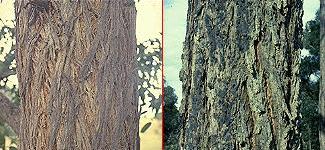|
[Front Page] [Features] [Departments] [Society Home] [Subscribe]

Bark
Betty Ballingall
The first Australians, the Aborigines, made use of bark in numerous ways. Small dishes were made to hold or transport articles, and also the coolamon or cradle for new-born babies could be made from bark. Bark was also used in various ways as coffins or to transport or contain the bones of the dead. Canoes were frequently made from bark, Although some shelters used bark for construction, it did not appear to be common.
This was left to the next Australians, the white settlers, who. used bark frequently as roofing material, In my Great Aunt's diary, she complains about all the little bowls scattered under the drips because the men had not got new bark for the leaking roof.
It was mostly the northern Aborigines who used bark for decorative or sacred artefacts. With the influence of tourist demand, this craft has become even more artistic and is a useful industry.
Around the 1950s, the European craft people introduced a new use for this material, the bark picture which, too, has developed into an attractive "painting" medium. This medium takes advantage of the colour and texture of the barks, which is just what the next artist will do in creating a focal point in the garden landscape.
 | |
 | |
 | |
A range of bark textures for Australian trees.
Clockwise from top right: Stringybark (Eucalyptus eugenioides), ironbark (E.fibrosa), bloodwood (Corymbia gummifera), paperbark (Melaleuca styphelioides), scribbly gum (Eucalyptus sclerophylla), spotted gum (Corymbia maculata). | |
When the early settlers arrived in Australia, they were astonished at the strange trees that shed their bark instead of their leaves. This habit has resulted in barks that have delightful colours and textures, a desirable and often overlooked feature when designing a garden landscape.
If choosing a plant for its decorative bark, it will have more impact if it is used as a feature specimen, placing it in a prominent position, or with plenty of space. Interesting bark is often better displayed on a smaller tree with a more twisted growth habit. however, those with straight tall trunks do have a pleasing grandeur or, if space allows, two or three in a group can have a very striking effect.
Eucalypts, in particular, have a variety of interesting barks. Species with white or creamy barks are generally well known. Perhaps not so many know that Eucalyptus erythronema, as well as its bright red flowers, has a snowy white, slender trunk. Since it only grows to 3 or 4 metres, it is an excellent subject for a small group.
The rich salmon colour of Angophora costata, Eucalyptus salmonophloia, the lesser known E.brockwayi and some forms of E.bancroftii are very eye-catching in season, but even more unusual are the species with fascinating polished bark of copper or bronze colours. Eucalyptus salubris, E.sargentii and E.diptera are slender, medium-sized trees with lovely glossy foliage. E.campaspe, with silvery foliage contrasting with its smooth copper trunk, is very elegant. A. delightful little tree to 4 metres is E.eremophila which, as well as a slender coppery trunk, has bright yellow flowers.
If the choice is for bark texture, the ironbarks are very ragged and bold, especially those with silver foliage against the black trunks. A different texture is provided by the orange, papery bark of E.peltata and others in this group. The most striking texture, however, is found on some small, Western Australian species, which have a minniritchi bark that curls to reveal bright reds and greens. E.orbifolia E.caesia and E.crucis are excellent examples, plus attractive silver foliage as well.
For areas not suited to some of these eucalypts, paper-barked melaleucas are a good choice, both for colour and for texture. Melaleuca decora is a small tree with character. The interesting bark and twisted habit, which displays the bark to advantage, makes an attractive feature. M.leucadendra and M.quinquenervia make a pleasing group if the garden is large enough, or if you have a damp spot, well away from plumbing of course.
 | |
Left - Leopardwood (Flindersia maculosa)
Right - Hakea lorea (syn. H.suberea).
Photos: Australian Plants Society | |
As well as Flindersia maculosa (leopardwood), which is an inland species, probably suiting drier conditions, both F.australis and F.collina shed bark in flakes which form attractive patterns.
Some of the corky-barked trees, such as the Duboisia and the inland hakeas, are very fascinating, the deeply furrowed bark being quite unique and the bonsai-like habit adding to the whole effect. One of the most extraordinary trees is Hakea suberea (now included in H.lorea - ed.) growing at the Harts Range racecourse on the Plenty Highway in the Northern Territory. They are like large crocodiles turned into trees, the ridges on their bark being 20cm or more deep. If they could be grown in gardens they be a certainly would conversation piece.
Considering the importance of bark to both plants and man, it is surprising to find it is mainly dead tissue formed from aged phloem cells, or from the corky material produced by the cork cambium, which is a band inside the bark.
Besides the few trees I have mentioned, there are many more with interesting bark.
From the September 1999 issue of the Bulletin of the Queensland Region of the Society for Growing Australian Plants. The article originally appeared in the April 1993 newsletter of the Toowoomba Society for Growing Australian Plants. Sadly Betty Ballingall passed away in 1998.

[Front Page] [Features] [Departments] [Society Home] [Subscribe]
Australian Plants online - March 2002
Association of Societies for Growing Australian Plants
|